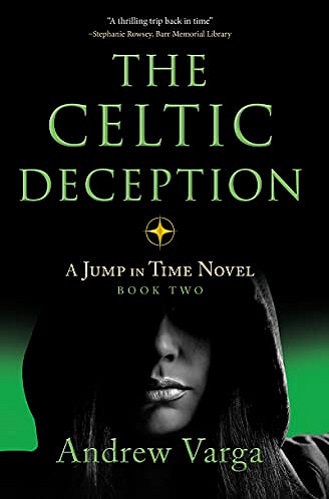Dan Renfrew hates that he’s a time-jumper – 17-year-olds should not be stuck with the responsibility of saving history. But with no one else stepping up to stop Victor Stahl’s plot to take over the world, Dan and his time-jumping partner Sam have no choice but to jump back into history again. They land on the Celtic island of Anglesey in 60 CE, hoping to find answers on how to stop Victor. Their task isn’t easy. Everyone seems to be hiding something, from the druids who rule Anglesey to the Celts who take the time-jumpers in. As two Roman legions – intent on wiping out everyone on the island – draw closer, time is running out for Dan and Sam.
Content warning: This review contains details pertaining to slavery and sexual violence.
I want to preface this review by saying that I still don’t know what to rate it. The three-star rating I’ve given it means nothing. The book, save for one major problem I’ll rant about soon, is easily a strong four-star story. So, let’s start with a few positives.
The overarching idea behind this book is incredible. A secret society of time-jumpers who bounce back and forth between eras, fixing glitches in history and fighting amongst each other. Awesome. I wish it weren’t so cut-and-dry as Victor is evil and wants to commit terracide, but the ideas behind the more concrete plot points are vastly workable and open the author up to a buffet of imaginative storylines.
Another high point here is the historical accuracy. While some of the cultural details included in this book are wholly unnecessary (again, rant later), I have to respect the hard work that went into building the Celtic society in the novel. There isn’t much recorded Celtic history at all (I checked) and the author found a way to weave that problem into the main character’s story early on. I liked that a lot – a well-crafted nod to the amount of research that went into the book, within the book itself. That was probably my favorite moment in the whole story.
The characters are mostly fun and consistent, the prose is excellent, the story is interesting and the world is accurate. But, even after all that, I cannot bring myself to recommend this book in its current state for one simple reason: The way the author and main character depict and portray women is concerning at best and, frankly, disgusting at worst.
I’ll start with the historically important details. Ancient Roman conquests were famously horrible, particularly towards women. This book contains multiple instances of on-page sexual violence, nudity and slavery, and while I was expecting it, having known the reputation of that period in history, not all readers will. At the very least, this book is written in a way that could be intensely emotionally triggering to those who have seen or experienced sexual violence, and it needs to be respectful of that fact. Add a content warning.
Now for the rant. Daniel, our main character, is an awkward, shy guy who can’t resist gawking at every woman in sight. Sure. Lots of teenage boys are like that, and it’s important for a book to relate to its target audience. The problem lies within the way he reacts, and the ridiculously unrealistic situations that lead to these moments in the first place. I didn’t run into a single instance of Daniel-female contact where I didn’t feel at least a little bit nauseous, and that’s a major issue, but two moments in particular were enough to force me to put the book down and go for a walk.
The first is when Atto’s wife essentially strips her clothes off and forces herself on Daniel near the beginning of the book. It is mentioned on-page later that it must have been because she was desperate to have a father figure for her children, but even then, this scene is handled like a toddler playing with high explosives. There are many ways to show desperation that don’t reduce a woman to her physical quantities, and this was the first of many scenes of “pretty Celtic women” throwing themselves and their bodies at Daniel for no reason. Even in the darkest moments in Roman captivity, where the men were starved and the women were abused, Daniel seemed almost jovially observant of all the beautiful naked Celtic women around him.
The second is near the end of the book, when Daniel is teaching Sam how to fight with a sword. Throughout the book, and very strictly in the pages prior, Sam is adamant that she does not want a relationship with Dan. She wants to be friends, and nothing more. So, of course, Dan’s first act as sword-fighting teacher is to make her strip down to her sports bra and spend the whole session staring shamelessly down at her chest. It doesn’t help that Sam’s character is incredibly inconsistent – sometimes urging that they need to stay as friends, and sometimes joking about seeing Dan naked or just outright kissing him for no reason. Dan obviously has no respect whatsoever for Sam’s boundaries, and at the end of the book, Sam caves and kisses him like she means it.
I’m not making this up. I really wish I was. Again, I have to circle back to the fact that it’s important to relate to a book’s target audience. It’s the job of a book like this to teach young boys to do better. Dan is the last type of person I would want my son to look at as a hero. This book evidently tries hard to be a narrative about strong women, but ends up feeling as much like some guy’s sexual fantasy as it does a novel with a plot.
I gave this book a three-star rating because I respect the good work that went into it. I respect the plot, the idea and the historical accuracy. I, however, cannot recommend this book. If it doesn’t change, I wouldn’t want it on any teenage boy’s bookshelf, for their sakes.
Happy (or not) reading!
-Matt Shipley


